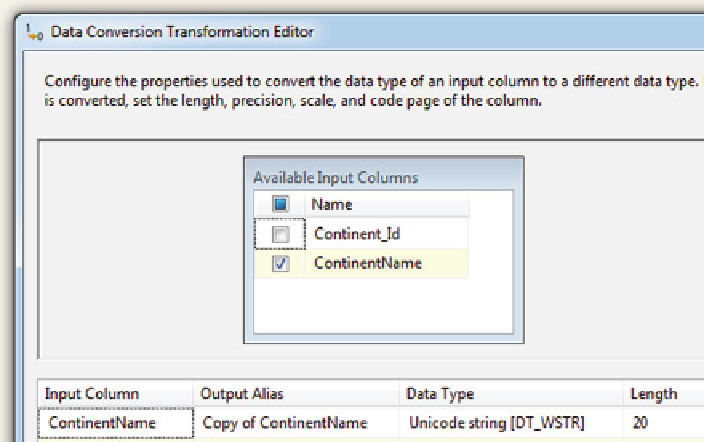Database Reference
In-Depth Information
Container is used for the three data flows that load the tables of the hierarchy.
Since
Continent
is the highest level in the hierarchy, we first need to produce
a key for it, so it can be later referenced from the
Country
level. The data
flow for loading the table
Continent
is given in Fig.
8.30
b. With respect to the
conceptual model given in Fig.
8.21
b, a data conversion is needed to convert
the data types from the XML file into the data types of the database. This is
shown in Fig.
8.31
,wherethe
ContinentName
, read from the XML file, is by
default of length 255, and it is converted into a string of length 20. Finally,
the
Continent
table is loaded, and a
ContinentKey
is automatically generated.
Fig. 8.31
Conversion of the data types that are input from the XML file
The data flow that loads the table
Country
is given in Fig.
8.30
c. With
respect to the conceptual model given in Fig.
8.21
b, a merge join transforma-
tion is needed to obtain for a given
Country
the corresponding
ContinentName
.
A data conversion transformation is needed to convert the data types from the
XML file into the data types of the database. Then, a lookup transformation
is needed to obtain, from the database, the
ContinentKey
corresponding to the
ContinentName
. This attribute is also added to the flow. Finally, the
Country
table is loaded analogously to the
Continent
table above. Notice that the data
flow that loads the table
State
is similar; therefore, we omit it.
Figure
8.32
shows the data flow for loading the
City
table. The conceptual
model for the data flow has been presented in Fig.
8.22
. The data flow
needs to associate to each city in the
TempCities
table either a
StateKey
or a
CountryKey
, depending on whether or not the corresponding country is
divided in states. For this, the conditional split tests if the
State
is null or not.

Search WWH ::

Custom Search